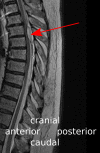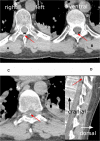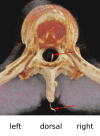Serious Complications After Epidural Catheter Placement: Two Case Reports
- PMID: 34335056
- PMCID: PMC8318213
- DOI: 10.2147/LRA.S324362
Serious Complications After Epidural Catheter Placement: Two Case Reports
Abstract
Thoracic epidural analgesia (TEA) is a standard procedure in multimodal analgesia applied in major thoracic and abdominal surgeries. Two cases are presented with serious complications related to TEA. In both cases, earlier reaction of the treating physicians to patient-reported sensory symptoms could have prevented the complicated course. The first case was a 73-year-old patient with bronchial carcinoma who underwent right lower lobe resection. In this case, dabigatran 150 mg/d (indication: permanent atrial fibrillation) had been discontinued 72 hours before surgery, and enoxaparin 80 mg (every 12 hours) had been started 11 hours after surgery. An epidural hematoma developed postoperatively. Magnetic resonance imaging (MRI) was performed only after paraplegia had developed the next day. Unfortunately, delayed hematoma evacuation could not prevent persistent paraplegia in this case, which was complicated by hospital-acquired pneumonia with sepsis and acute renal failure. The second case was a 39-year-old patient with ulcerative colitis and an initially undetected malposition of the epidural catheter. Immediately after test bolus injection, the patient reported paresthesia and overall discomfort, which however could not be safely attributed to either the test dose or the already started general anesthesia. The patient could only be extubated after stopping the epidural infusion. Accidental re-start of epidural infusion led to coma, conjugate eye deviation, and respiratory arrest, necessitating re-intubation. Computed tomography (CT) ruled out intracerebral pathology and showed a catheter position centrally in the spinal canal. Fortunately, no neurological deficits were detected after catheter removal.
Keywords: dabigatran; epidural analgesia; paraplegia; perioperative complications.
© 2021 Seidel et al.
Conflict of interest statement
The authors report no conflicts of interest in this work.
Figures



Similar articles
-
Spinal cord infarction following epidural and general anesthesia: a case report.JA Clin Rep. 2017;3(1):42. doi: 10.1186/s40981-017-0109-2. Epub 2017 Aug 16. JA Clin Rep. 2017. PMID: 29457086 Free PMC article.
-
Rapid development of a spinal epidural hematoma following thoracic epidural catheter removal in an esophageal carcinoma surgical patient: a case report.JA Clin Rep. 2016;2(1):37. doi: 10.1186/s40981-016-0060-7. Epub 2016 Nov 14. JA Clin Rep. 2016. PMID: 29492432 Free PMC article.
-
[Epidural hematoma after removal of an epidural catheter].Rev Esp Anestesiol Reanim. 1998 Aug-Sep;45(7):294-7. Rev Esp Anestesiol Reanim. 1998. PMID: 9780766 Spanish.
-
Spontaneous Spinal Epidural Hematoma After Normal Spontaneous Delivery with Epidural Analgesia: Case Report and Literature Review.World Neurosurg. 2020 May;137:214-217. doi: 10.1016/j.wneu.2020.01.240. Epub 2020 Feb 10. World Neurosurg. 2020. PMID: 32058108 Review.
-
Postoperative spinal epidural hematoma at a site distant from the main surgical procedure: a case report and review of the literature.Spine J. 2010 Apr;10(4):e21-5. doi: 10.1016/j.spinee.2010.02.011. Spine J. 2010. PMID: 20362244 Review.
Cited by
-
Spinal Cord Injury and Complications Related to Neuraxial Anaesthesia Procedures: A Systematic Review.Int J Mol Sci. 2023 Feb 28;24(5):4665. doi: 10.3390/ijms24054665. Int J Mol Sci. 2023. PMID: 36902095 Free PMC article.
-
Epidemiologic investigation on neurological complications following neuraxial anesthesia in 2.7 million cases in Southwest China.Sci Rep. 2025 Apr 18;15(1):13497. doi: 10.1038/s41598-025-98142-5. Sci Rep. 2025. PMID: 40251408 Free PMC article.
References
-
- Cummings KC, Zimmerman NM, Maheshwari K, et al. Epidural compared with non-epidural analgesia and cardiopulmonary complications after colectomy: a retrospective cohort study of 20,880 patients using a national quality database. J Clin Anesth. 2018;47:12–18. doi:10.1016/j.jclinane.2018.03.005 - DOI - PMC - PubMed
-
- Melloul E, Lassen K, Roulin D, et al. Guidelines for perioperative care for pancreatoduodenectomy: enhanced recovery after surgery recommendations 2019. World J Surg. 2020;44:2056–2084. - PubMed
Publication types
LinkOut - more resources
Full Text Sources

